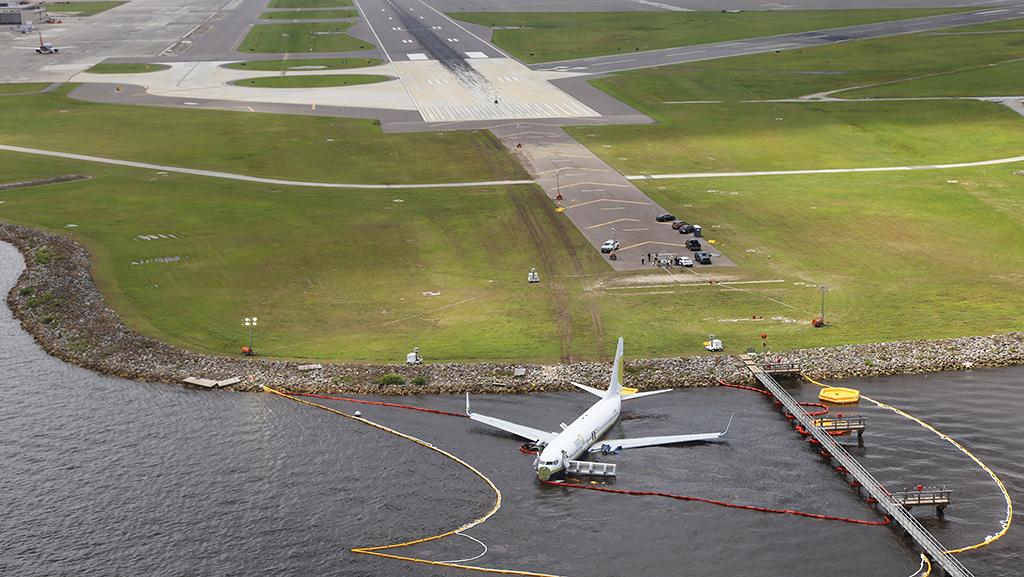
A multiyear U.S. review of commercial aircraft evacuations shows that overall safety is very high, but the FAA concedes some areas can be improved and wants public input to help it shape possible regulatory changes.
“Due to regulatory advancements and improvements in materials and training, the safety of commercial aircraft has improved with regard to evacuation and occupant protection,” the FAA said in a report provided to Congress earlier this year. “Nonetheless, the FAA recognizes that the factors affecting evacuation are continually evolving and several areas for improvement exist.”
The FAA’s study was prompted by a 2018 U.S. law that ordered it to review evacuation certification standards, focusing on three areas: Are passengers and crew members able to evacuate; how long do they have in given accident scenarios; and how fast can they leave the aircraft? The agency then would use its findings to update rules and guidance.
The agency chartered a rulemaking advisory committee, which looked at more than 290 evacuations over 10 years and made recommendations. The FAA also conducted evacuation simulations that helped form the basis of a January 2021 FAA Civil Aerospace Medical Institute (CAMI) report.
Among that report’s conclusions: Current seat pitch and size combinations “can accommodate and not impede egress for 99% of the American population,” the report’s abstract said. “This project also concluded that, similar to previous evacuation research, as long as ergonomic minimums are maintained, the transport airplane’s interior configuration, including seat pitch and width, has not been shown to influence evacuations.”
Among the FAA’s conclusions: Many passengers do not understand how to evacuate using over-wing exits with no slides. The agency plans to work with other global regulators to study ways to better identify over-wing evacuation paths.
Another issue is evacuations from aircraft with at least one landing gear leg failure. While the regulations address the issue, the committee found a lack of standardization among manufacturers on issues such as minimum sill heights or distance from the ground that exits must be if landing gear fails. “The FAA recommends updating guidance for determining aircraft attitudes and measuring sill heights corresponding to the loss of one or more legs of landing gear,” the agency said.
The FAA also will examine emergency exit lighting standards. While it does not plan to mandate retrofits, increasing standards for future models can introduce safety improvements with minimal disruption to the in-service fleet, the agency said.
Two issues related to flight crew stood out. Most applicable non-normal and emergency evacuation checklists are too complicated, and deciding when to initiate an evacuation is too ambiguous. A related finding concluded that too many evacuations took place during clear non-emergencies, and protocols—including crew-commanded evacuation procedures—were not followed. The agency plans to develop guidance that will help aircraft manufacturers “review and revise, as necessary, the Emergency Evacuation Checklist to ensure the actions included on the checklist are logical, necessary and appropriately ordered.” It also will recommend more training for cockpit and cabin crew members.
While the agency did not find a rationale to change minimum seat pitch or size standards, it concedes that collecting more data on the issue—and evacuations in general—“could be valuable,” the FAA said in an early August request for public input.
The public notice asks for “comments to assist the agency in determining what minimum dimensions (including pitch, width and length) of passenger seats may be necessary for safety, including in particular airplane evacuation,” it said. “Commenters are asked to provide information regarding the minimum seat dimensions necessary to ensure safety during airplane evacuation of a broad range of passengers, including those who were not included in the CAMI study.”
Several categories of passengers were not represented in the CAMI study, including children, people over age 60 and disabled individuals.
The agency will take input for 90 days, or until early November. As of mid-August, the FAA had received more than 9,500 comments.





